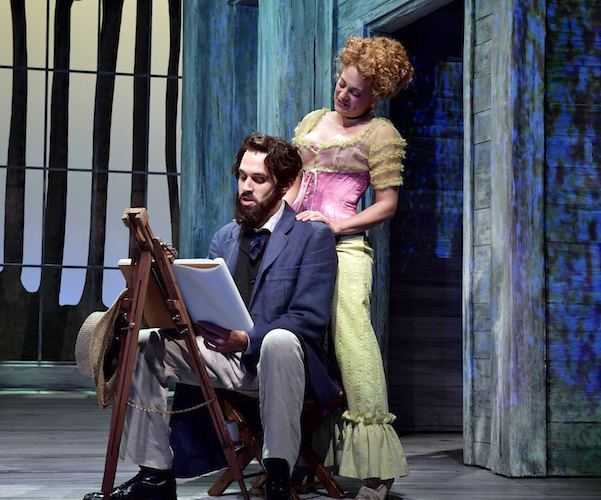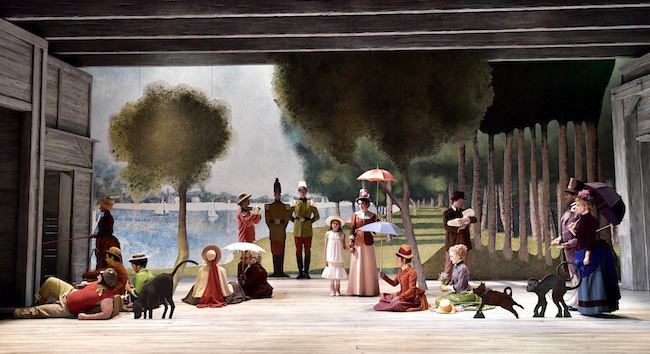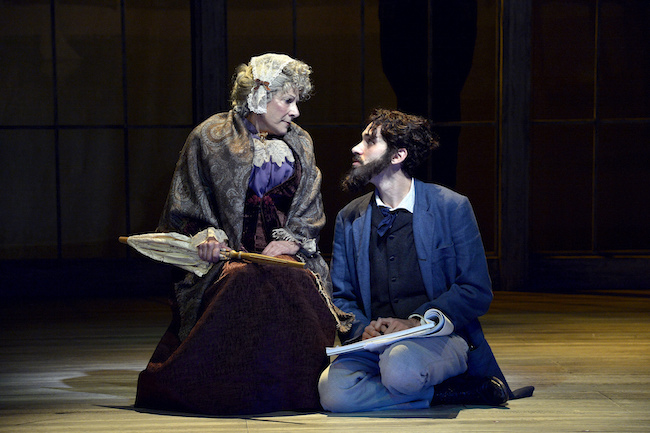Fuse Theater Review: Sondheim’s Scintillating Portrait of the Artist — Sunday in the Park with George
The cherry on top of this terrific production is its stunning technical design, from lighting and sets to sound, projection, and costumes.
Sunday in the Park with George. Music and lyrics by Stephen Sondheim. Book by James Lapine. Directed by Peter DuBois. Choreographer, Daniel Pelzig. Music director, Eric Stern. Scenic design, Derek McLane. Costume design, Robert Morgan. Lighting design, Christopher Akerlind. Sound design, Jon Weston. Projection design, Zachary G. Borovay. Orchestrations and new Chromolume music, Michael Starobin. Huntington Theater Company, BU Theatre, 264 Huntington Ave., Boston, MA, through October 16.

Adam Chanler-Berat and Jenni Barber in the HTC production of “Sunday in the Park with George.” Photo: Paul Marotta.
By Evelyn Rosenthal
With this breathtakingly beautiful production of the Pulitzer prize–winning musical Sunday in the Park with George, Peter DuBois is off to a grand start in his multiyear project of bringing all the musicals for which Stephen Sondheim wrote both music and lyrics to the Huntington Theatre. While some of these, he has said, may be productions that originate elsewhere, it’s not a surprise that DuBois chose to direct this most personal of Sondheim’s musicals, the one that speaks most directly to, and about, those who make art.
The Sunday of the title is the one depicted in French painter Georges Seurat’s masterpiece A Sunday Afternoon on the Island of La Grande Jatte. Sondheim brilliantly imagines the painting’s creation, shining his music and trenchant lyrics on the artist himself and on many of the figures populating the canvas, including two dogs and a monkey. He conjures characters Seurat might have sketched on various Sundays in the mid-1880s in a park at the edge of Paris—a rough boatman and his pooch; two coquettish shop girls and the soldier they vie for; the artist’s elderly mother and her nurse; a fellow artist, his wife, daughter, and their two servants; the artist’s mistress.
At its heart, the musical is a portrait of an artist—make that two artists, both named George—struggling with conflicts that every artist faces: trying to make something new and original; dealing with criticism and the market; reconciling the demands of making art and having a life. In Act I, Seurat (called George, sans “s”) is obsessed with turning his visions of color and light into what became his artistic breakthrough, the style of dots and daubs of paint later dubbed “pointillism.” Adam Chanler-Berat movingly conveys George’s awkwardness, his passion for his art, and his yearning for it to be recognized and understood, as well as his sorrow at losing his mistress—the drolly named Dot—because of his single-minded dedication to his work. Though lacking power at the high end, Chanler-Berat’s voice is expressive and sweet, particularly in the duet “Beautiful” with the Old Lady (George’s mother), played by Bobbie Steinbach. A memorable Madame Armfeldt in last season’s splendid Huntington A Little Night Music, she is just as touching here as a woman slipping into her own world of memories, lamenting the loss of trees that were never there. The versatile Steinbach also breaks up the audience with her transformation into the hip 1980s New York composer who collaborates with Act II’s George, Seurat’s great-grandson, on his multimedia extravaganza.

Company of the HTC production of “Sunday in the Park with George.” Photo: Paul Marotta.
If the heart of the show is George and his painting, its soul is Dot. Jenni Barber shines in every way—and in every musical number—as the mistress and model who loves both George and his art, but can’t live with his emotional distance. Among Sondheim’s many wonderful female roles, Dot is one of the most three-dimensional and compelling—wry, spirited, sure of what she wants, emotionally astute. With her gorgeous voice and stellar acting, Barber thoroughly conveys Dot’s bemusement and joie de vivre, her frustration and heartbreak. She is equally affecting in Act II as the second George’s grandmother Marie (the child of Dot and the first George). I doubt there were many dry eyes in the house when she sang “Children and Art,” Sondheim’s paean to the “only two worthwhile things to leave behind when you depart this world,” a belief at the core of much of his work.
Other standouts in the fine cast include Josh Breckenridge as Jules, George’s successful painter friend, and Aimee Doherty as his wife Yvonne. The two deliciously deliver “No Life,” a catty critique of one of George’s paintings. And in a nice switch from the original doubling of the cast, Doherty also plays the art critic who is unimpressed by the second George’s seventh iteration of his “light machine”: “I was hoping it would be a series of three—four at the most.”

Bobbie Steinbach and Adam Chanler-Berat in the HTC production of “Sunday in the Park with George.” Photo: Paul Marotta.
The cherry on top of this terrific production is its stunning technical design, from lighting and sets to sound, projection, and costumes. Appropriately for a show about creating a work of art, DuBois and his designers have done just that. Whitewashed studio walls morph via projections into park, painting, and a museum gallery where the modern-day George is debuting “Chromolume #7.” While the original 1984 production featured a crude sci-fi contraption resembling a giant salt shaker with a disco ball on top and light shooting out of holes, the Huntington’s version is an immersive light show with surround sound blasting new music by Michael Starobin and brilliant colors that encompass the entire stage. Subtler effects also work their magic: trees and cutout versions of dogs (and hilariously posed cutouts of 1980s George) easily slide or pop up on stage and disappear; the gallery party set and costumes scream modern art in black, gray, and white with touches of red; the 19th-century characters dazzle in outfits that take their colors from Seurat’s painting—brick reds and blues, greens and purples and mauves.
Adding to the embarrassment of riches are Sondheim’s gorgeous music, ably played by an 11-piece orchestra under the direction of Eric Stern, and his words—expertly veering, as they do in all his works, between the sharpest comedy and the most profound insights. DuBois has managed to wring every comic drop out of the show and still leave us moved by the efforts of Sondheim’s two artists—and perhaps the composer himself?—to be true to their artistic visions and to connect meaningfully with others.
Evelyn Rosenthal is the former editor in chief and head of publications at the Harvard Art Museums. She is also a professional singer, specializing in jazz and Brazilian music. She writes about musical theater, music, and books for the Arts Fuse.
Tagged: Adam Chanler-Berat, Huntington-Theatre-Company, Jenni Barber, Peter-DuBois, Stephen-Sondheim
